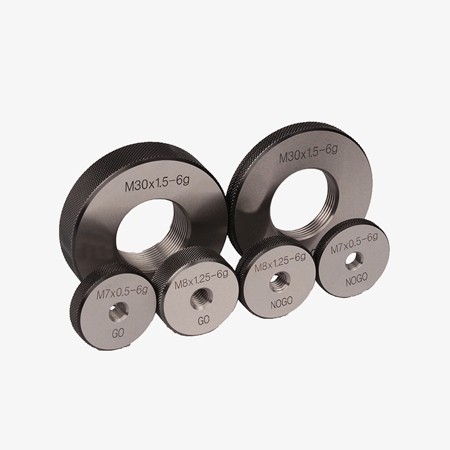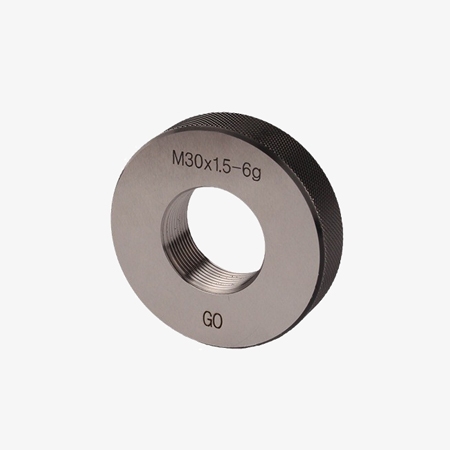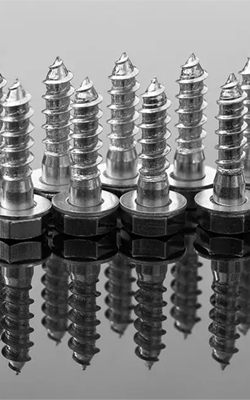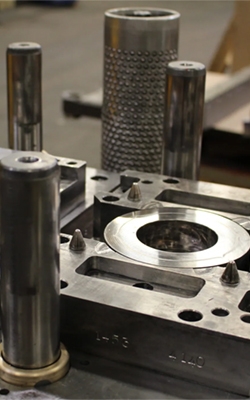SISCO thread ring gauge with standard thread checker's 6G for metric measurements features high precision, wear resistance, durability, accurate precision, and stable structure, making it ideal for consistent and reliable measurements.

Design and Material Characteristics for Durability and Accuracy
- High Accuracy: The gauge ensures precise thread measurements, meeting strict standards and preventing assembly issues caused by dimensional errors.
- GCr15 Bearing Steel: The metric go/no go thread ring gauge is made of GCr15 bearing steel, subjected to rigorous heat treatment, achieving a hardness of 58-65HRC, with enhanced wear resistance and contact fatigue strength, making it less prone to deformation.

Thread Measurement Standards and Efficiency Enhancements
- Defined Thread Standards and Limit Grades: Following international standards and defined grades (e.g., 6G, 6H) ensures consistent, industry-compliant thread fits across various applications.
- Nominal Size and Pitch Marked for Easy Use: Clear markings of nominal size and pitch on each gauge allow quick identification and accurate measurements, improving efficiency and reducing errors.
Applications
A go and no go thread ring gauge is primarily used to verify the external threads of fasteners such as bolts, screws, and studs, ensuring they meet the required ISO metric thread standards with medium tolerance. It is commonly applied in quality control and inspection processes to check thread fit, ensuring that external threads align correctly with internal threads, like nuts or tapped holes, for optimal engagement. By confirming that threads are within permissible limits, the 6G gauge helps prevent issues such as cross-threading or poor performance, making it essential for industries like automotive, aerospace, and manufacturing. Additionally, it is used in maintenance and repair to inspect components for reuse, providing a reliable and efficient way to ensure thread integrity across various applications.

Thread Identification

Tool and Die Making

Automotive Industries

Machine Manufacturing
| Model | SISCO-TG-6G |
| Accuracy | M0.8 - M0.2, M1.0 - M0.25, M1.2 - M0.25, M1.4 - M0.2, M1.5 - M0.35, M1.6 - M0.2, M1.7 - M0.2, M1.8 - M0.3, M2 - M0.4, M2.2 - M0.45, M2.3 - M0.4, M2.5 - M0.35, M3 - M0.5, M3.5 - M0.35, M4 - M0.7, M4.5 - M0.75 |
| Material | Bearing Steel |
| Thread Type | UNF |
| Single or Double Ring | Single |
| Weight | ±0.5kg |
Q1: What standards are used for thread gauges?
A1: Thread gauges are manufactured and calibrated according to various international and regional standards to ensure accurate and consistent measurements across applications. The most common standards include ISO (International Organization for Standardization) standards for metric threads, ANSI/ASME (American National Standards Institute/American Society of Mechanical Engineers) standards for unified threads in the U.S., BS (British Standard) for British Standard Whitworth (BSW) and British Standard Pipe (BSP) threads, and DIN (Deutsches Institut für Normung) for German threads. Additionally, there are standards like JIS (Japanese Industrial Standards) for Japanese thread specifications. These standards define parameters such as thread angle, pitch, and tolerances, ensuring compatibility and performance across diverse industries and applications.
Q2: How to know what size thread to use?
A2: To determine the correct thread size to use, you first need to identify key parameters of the threaded component: thread diameter, thread pitch (distance between threads), and thread type (metric, imperial, or another standard). Using a thread gauge is a simple way to measure these features, as it can help match the pitch and determine if the thread is coarse or fine. Additionally, consulting technical documentation, such as engineering drawings, standards tables, or specifications, can provide guidance on the appropriate thread size for a particular application. Consider factors like load-bearing capacity, material strength, and compatibility with mating parts to ensure the chosen thread size meets functional and safety requirements.
Q3: What does "6G" mean in threading?
A3: In threading, "6G" is a tolerance class for metric threads specified by ISO standards, indicating a medium-fit tolerance between mating internal and external threads. It defines the allowable limits of deviation for the thread's size, with "6" representing a standard tolerance grade and "G" denoting the position of the tolerance zone relative to the basic profile, typically offering more clearance than tighter fits such as 6H or 5G. This fit is commonly used for general-purpose applications, balancing ease of assembly with a secure and functional engagement.
Tips: How should thread ring gauges be maintained?
To maintain a thread ring gauge, it is important to handle it with care to prevent damage or wear.
Regularly clean the gauge using a soft brush or lint-free cloth to remove dirt, debris, or any residue from use, as buildup can affect accuracy.
Store the gauge in a dry, controlled environment, away from moisture and humidity, to prevent corrosion.
Apply a light coat of rust-preventive oil when not in use, especially if stored for long periods. Periodically check and calibrate the gauge against master standards to ensure accuracy and detect any wear or distortion that might compromise its precision.
Avoid over-tightening or forcing threads during use, as this can lead to damage and reduced lifespan.
Thank you for buying industrial test and measurement equipment on SISCO.com, all products sold by SISCO and the partner cover a 12 months warranty, effective from the date of receiving the products.
What is covered?
SISCO is responsible for providing free spare parts, and free technical support to assist the customer to repair the defective products until the problem is solved.
What is not covered?
- Product purchased from anyone other than a SISCO store or a SISCO authorized reseller.
- Expendable parts.
- Routine cleaning or normal cosmetic and mechanical wear.
- Damage from misuse, abuse or neglect.
- Damage from use of parts other than SISCO approved.
- Damage from use outside the product’s usage or storage parameters.
- Damage from use of parts not sold by SISCO.
- Damage from modification or incorporation into other products.
- Damage from repair or replacement of warranted parts by a service provider other than a SISCO authorized service provider.
- Damage caused by the application environment not meeting the product usage requirements and the failure to perform preventive maintenance.

